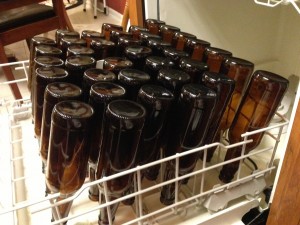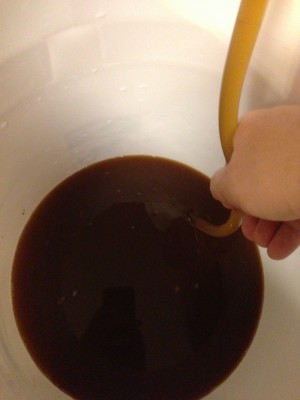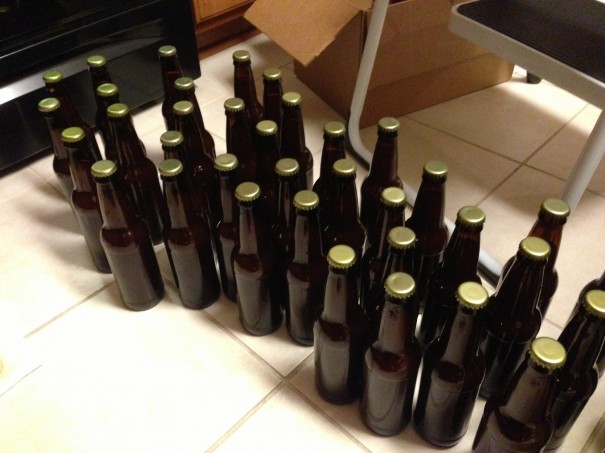My First Homebrewing Experience Part 2
Ken was right; bottling is basically the worst.
 This kit didn't come with a secondary fermenter, so the fermentation all occurred in the primary fermenter over two weeks. I brought the fermenter out and put it on the counter, opening the lid. It smells pretty good, but first the bottles and equipment need to be sanitized. Clean bottles are fairly easy to sanitize; just put them in the dishwasher. The heat of the drying cycle is enough to sanitize the bottles. 38 bottles fit on the bottom rack of the dishwasher, so I had to do them in two batches. Everything else is sanitized with a new batch of the no-rinse sanitizer the kit came with.
This kit didn't come with a secondary fermenter, so the fermentation all occurred in the primary fermenter over two weeks. I brought the fermenter out and put it on the counter, opening the lid. It smells pretty good, but first the bottles and equipment need to be sanitized. Clean bottles are fairly easy to sanitize; just put them in the dishwasher. The heat of the drying cycle is enough to sanitize the bottles. 38 bottles fit on the bottom rack of the dishwasher, so I had to do them in two batches. Everything else is sanitized with a new batch of the no-rinse sanitizer the kit came with.
Priming sugar to carbonate the beer also needs to be prepared. For this, corn sugar is added to a half a cup of water, boiled for five minutes, then left in the pot to cool. After cooling the priming sugar is put into the bottling bucket. The priming sugar allows the yeast to consume it in order to carbonate the beer when the beer is in the bottles.
The beer needs to be moved from the fermenting bucket to the bottling bucket by siphon. This is where an auto-siphon, a tool that pumps the beer up into the siphon to start it, would have been useful. I managed to get the siphon going without one. The beer goes up the racking cane and down the tubing into the bottling bucket where the beer mixes with the priming sugar.

Once the beer has been transferred, the tubing is attached to a spigot on the bottom of the bottling bucket and a filling nozzle is attached to the other end of the tubing. One by one the bottles are filled with the nozzle and capped. This took quite a while (and was a bit of a mess) but I had 44 bottles of beer by the time I was finished.

According to the kit it will take another two weeks for the bottles to carbonate and therefore be ready to drink. Thus far I feel like there are a few things I could use to add to my homebrewing kit:
A wort chiller in order to cool the wort faster and more easily.
A carboy (a large bottle made of plastic or glass, similar to a 5 gallon bottle of water for an office water cooler) to use as a secondary fermenter. I did notice a lot of sediment in the fermenter; transferring to a secondary fermenter is supposed to help make a clear beer.
An auto-siphon in order to easily start the siphoning from one vessel to another.
Next time I talk about homebrewing I'll actually be tasting the beer that went through this process. Hopefully it doesn't suck.